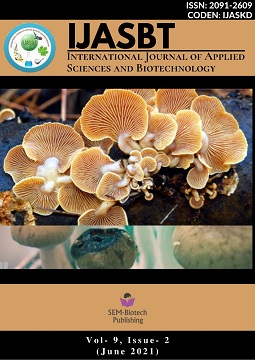Major Fungal Contaminants of Mushrooms and Their Management
DOI:
https://doi.org/10.3126/ijasbt.v9i2.37513Keywords:
Fungal contaminants, Mushroom, Mycogyne, Trichoderma, Sterilization, Biological controlAbstract
Mushrooms are known for several nutritional and medicinal benefits and are cultivated worldwide. Several fungal contaminants of mushrooms have been serving as the major restraining factor in the growing mushroom industry for a long time. Fungal contaminants like Trichoderma spp., Mycogone spp., Lecanicillium spp., Cladobotryum spp., Coprinus spp., Sependonium spp., Sclerotium rolfsii, and Cephalothecum roseum among many, are found to infect mushroom crops at different stages from spawn run period to maturation of fruiting bodies. These contaminants may reduce yield and/or degrade the quality of fruiting bodies of the mushroom causing economic losses. These contaminants are usually peculiar in terms of their symptomatology on the substrates, disease cycle, epidemiological requirements, and yield losses. Most of these contaminants come from poorly sterilized substrates. Several sterilization techniques like steam sterilization, hot water sterilization, alkalinization, bleaching, and chemical sterilization can be employed to eliminate pre-existing contaminants and each technique has its own relative advantage over others. Besides, biological control involving botanicals and live antagonists can also be used as prophylactic sterilant or as therapeutic sprays. Biological control measures are friendly to the environment and human health. Unlike chemical fungicides (used as sterilant or spray), biological control measures don’t inhibit mushroom mycelial growth and even don’t raise the problem of pesticide resistance in pathogens. Roguing out of infected mushroom fruiting bodies or beds, mushroom house sanitation, and management of vector population are also equally important in preventing the spread of the fungal diseases of mushrooms.
Int. J. Appl. Sci. Biotechnol. Vol 9(2): 80-93




